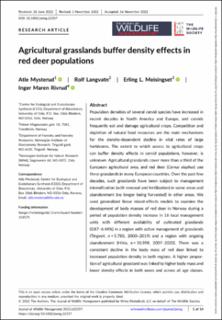| dc.contributor.author | Mysterud, Atle | |
| dc.contributor.author | Langvatn, Rolf | |
| dc.contributor.author | Meisingset, Erling L. | |
| dc.contributor.author | Rivrud, Inger Maren | |
| dc.date.accessioned | 2023-03-01T17:04:13Z | |
| dc.date.available | 2023-03-01T17:04:13Z | |
| dc.date.created | 2023-01-13T13:03:07Z | |
| dc.date.issued | 2022-12-29 | |
| dc.identifier.citation | Journal of Wildlife Management. 2022, . | en_US |
| dc.identifier.issn | 0022-541X | |
| dc.identifier.uri | https://hdl.handle.net/11250/3055134 | |
| dc.description.abstract | Population densities of several cervid species have increased in recent decades in North America and Europe, and cervids frequently eat and damage agricultural crops. Competition and depletion of natural food resources are the main mechanisms for the density-dependent decline in vital rates of large herbivores. The extent to which access to agricultural crops can buffer density effects in cervid populations, however, is unknown. Agricultural grasslands cover more than a third of the European agricultural area, and red deer (Cervus elaphus) use these grasslands in many European countries. Over the past few decades, such grasslands have been subject to management intensification (with renewal and fertilization) in some areas and abandonment (no longer being harvested) in other areas. We used generalized linear mixed-effects models to examine the development of body masses of red deer in Norway during a period of population density increase in 16 local management units with different availability of cultivated grasslands (0.87–6.44%) in a region with active management of grasslands (Tingvoll, n = 5,780, 2000–2019) and a region with ongoing abandonment (Hitra, n = 10,598, 2007–2020). There was a consistent decline in the body mass of red deer linked to increased population density in both regions. A higher proportion of agricultural grassland was linked to higher body mass and lower density effects in both sexes and across all age classes. There is a link between body mass, survival, and reproduction. Therefore, the buffering of density effects of access to agricultural crops will fuel cervid population growth and lead to less natural regulation of abundance, making it more difficult to control dense cervid populations by harvesting. | en_US |
| dc.language.iso | eng | en_US |
| dc.publisher | Wiley Periodicals LLC on behalf of The Wildlife Society | en_US |
| dc.rights | Navngivelse 4.0 Internasjonal | * |
| dc.rights.uri | http://creativecommons.org/licenses/by/4.0/deed.no | * |
| dc.title | Agricultural grasslands buffer density effects in red deer populations | en_US |
| dc.title.alternative | Agricultural grasslands buffer density effects in red deer populations | en_US |
| dc.type | Peer reviewed | en_US |
| dc.type | Journal article | en_US |
| dc.description.version | publishedVersion | en_US |
| dc.rights.holder | © 2022 The Authors | en_US |
| dc.source.pagenumber | 14 | en_US |
| dc.source.journal | Journal of Wildlife Management | en_US |
| dc.identifier.doi | 10.1002/jwmg.22357 | |
| dc.identifier.cristin | 2106555 | |
| dc.relation.project | Norges forskningsråd: 318575 | en_US |
| dc.source.articlenumber | e22357 | en_US |
| cristin.ispublished | true | |
| cristin.fulltext | original | |
| cristin.qualitycode | 1 | |

